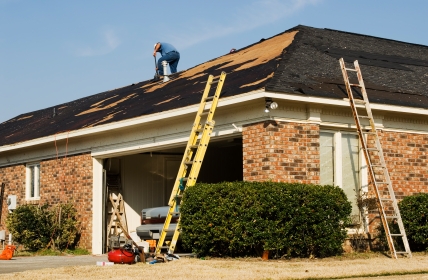The roof is exposed to the weather around the clock and while it was designed and built to cover and protect the top of a building, it can still break down and leak into interior spaces. Regardless of leak cause, whether it is due to poor quality material, bad construction, or severe weather, it is imperative that repairs be made to prevent any further damage to the remaining structure.
protect the top of a building, it can still break down and leak into interior spaces. Regardless of leak cause, whether it is due to poor quality material, bad construction, or severe weather, it is imperative that repairs be made to prevent any further damage to the remaining structure.
It is plausible to wonder how easy or how hard it may be to repair a roof. The truth is, although it depends on several factors, most damage is usually minor and can be handled without the help of a professional. Following are some common minor damages that can be easily mended without the services of an expert.
Problems
Although this list is far from inclusive of every problem encountered, it does include some of the more common ones:
- Missing Shingles – Missing shingles is a common problem, especially on homes located in windy areas or after a severe storm. This issue needs to be addressed immediately as the gap left from any missing shingles can create a wind drag that causes surrounding tiles to rip off with another gust of wind, causing a cascading effect. When replacing individual shingles, remove any broken pieces and inspect surrounding tiles for cracks that could cause further breakage. Use a tile that is identical in length and width and be sure it is well seated with the surrounding tiles, leaving no gaps for water to seep through with adequate overlap between tiles.
- Valley Leaks – The valley is the structural part that is the most prone to severe leaks. Water tends to accumulate in these areas and make its way through shingles and underlayment and sheathing. A poorly constructed valley can allow large amounts of water to seep through, causing extensive interior damage; however, it can be easily fixed. There are leaks in these valleys due to lack of overlap. When repairing it, the length of the shingles should not end at the lowest point of the valley; a generous amount of overlap should be included so that at least one-quarter of tabbed shingles crosses it. Shingle ends should be woven at the valley point; be sure not to nail six inches from the valley.
- Loose Flashing – Flashing is a strip of metal used to seal the gaps between shingles and other components such as a chimney. Various factors can cause flashing to loosen such as strong wind, hail, and even thermal shock. Once the gap is open, water can pool and cause extensive damage to other underlying components. For a temporary repair, place the folds back into the brick and apply mortar or sealant to hold it in position.
- Loose Fasteners – Fasteners can loosen because of strong wind and extensive corrosion which in turn leaves a hole for water seepage. When replacing a fastener, select one with a wide head or a rubber gasket so it can effectively seal the hole. A sealant can also be applied at the base of the head as an alternative.
Important Considerations
Before tackling a roof repair, consider the extent of the damage and whether it requires professional help. Some fixes may only require basic handyman skills while other occasions require the help of a professional roofer is required such as when the damage is too large for a one-man team or the slope is too steep for an amateur to scale. The structure’s age should also be considered since material that is beyond its intended lifespan may develop damage too severe to be repaired and will require replacement of the entire structure.
Roof repair is neither easy nor difficult; it solely depends on the extent of the damage. Hopefully this article has explained the types of roof damage that are easy to fix and some possible repairs – or if it is time to call in the professionals!
Let Schulte Roofing be Your Roofer Houston Expert!
Have you been looking for a roofer Houston to make necessary roof repairs? Contact the experts at Schulte Roofing at 800-367-7663 who can provide roofing repair services to all greater Houston area customers!
